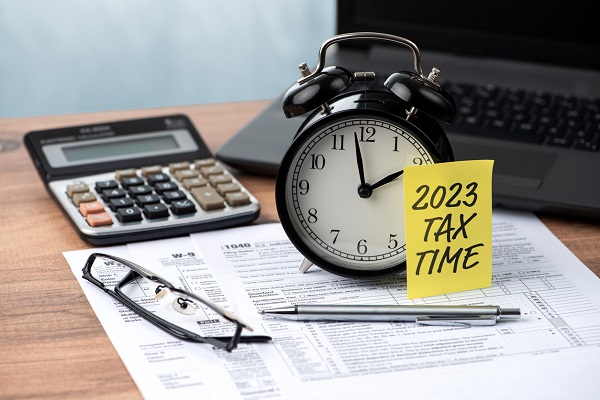Six things you need to know about your tax return
4th January 2023 11:00
by Rachel Lacey from interactive investor
With the tax return deadline approaching fast, we explore the tax return rules and how understanding them could help you save tax in 2023.

Nobody relishes the prospect of completing their tax return. It doesn’t matter whether you’re doing it for the first time or the umpteenth, it’s a chore with a capital ‘C’.
In terms of the financial admin, however, it needs to be right there at the top of your list. It’s all about staying on the right side of the proverbial tax man - fail to complete your tax return, or miss the deadline and you’ll be hit with a fine.
But while you can’t duck out of your tax return, there are ways to make it less of a headache. In some cases, you may even be able to turn it to your advantage and use it to reduce the amount of tax you pay.
- Learn more: How does SIPP Tax Relief Work? | SIPP Inheritance Tax | Open a SIPP
To get you started, we outline the self-assessment rules you need to be aware of and share a few tips to get your tax return working for you.
1) Know your deadlines – and the fines for missing them
You’ve got until the 31 January 2023 to file your tax return and pay any tax you owe for the last tax year (which ran from 6 April 2021 to 5 April 2022). The deadline for paper returns passed on 31 October, so the only option now is to complete it online.
The penalty for filing your tax return late is £100, more if it’s over three months late. Interest could be charged on late payments too.
2) Declare your capital gains as well as your income
We tend to associate our tax returns with the payment of income tax. But if you’ve sold any assets during the tax year and made gains in excess of the capital gains allowance, you’ll also need to report those on your tax return. (The exception here is for land and property sales – where you’ll need to file a separate return and report it to HMRC within 60 days.)
Following changes announced in the Autumn Statement, it could become all too easy to fall foul of these rules over the coming years.
- Use this neat ISA trick to avoid a big tax bill in 2023
- Thousands of Brits could be breaking the law after CGT changes
This is because the CGT allowance is being cut from its current level of £12,300 to £6,000 in 2023 and £3,000 in 2024, meaning much smaller gains will start becoming liable.
3) Don’t forget your pensions tax relief
Your tax return isn’t just about paying tax. It’s also your opportunity to make sure you’re getting the right amount of tax relief on your pension contributions.
Overlook questions on how much you pay into your pension and you’ll miss the opportunity to cut your tax bill, or give your retirement savings a serious boost.
Some schemes will only apply basic rate tax relief to your contributions. That means if you pay a higher rate of income tax you may need to claim the additional tax relief you’re entitled to through your tax return.
This is likely to apply if you have a personal pension you arranged yourself, such as a self-invested personal pension, or SIPP.
It may also be the case with some workplace schemes. The crux is to find out whether it’s a ‘net pay’ or ‘relief at source’ arrangement.
With net pay schemes, your pension contributions are paid before your tax has been deducted, which means tax relief is automatically paid at the correct rate for you. This is nice and straightforward, so you don’t have to take any further action.
However, if it’s a relief at source scheme, your contributions will have been deducted from your taxed income. This makes life a bit more complicated as your scheme will then need to reclaim tax relief from HMRC, which it will then pay into your pension. This will only be at the basic rate, so if you pay the higher or additional rate, you’ll need to claim the difference back through your tax return.
If you have a relief at source pension – whether it’s a workplace or personal scheme – and you pay a higher rate of income tax, you’ll need to enter your total pension contributions for the tax year on your tax return. Note that this needs to be gross contributions, including your basic rate tax top-up.
Check your pension statement to get this info, or ask your pension provider if you’re not sure.
- Six ways to turbocharge your pension with a new-year makeover
- 10 essential things to know about pension tax relief
There are three ways tax relief might be paid back to you; as a reduction to your tax bill, a rebate, or you might get your tax code adjusted for the coming year.
It’s up to you whether you use any rebate to top up your pension.
If you’ve been missing out on this until now, you may be able to make backdated claims for tax relief on pensions contributions for the last three tax years. Check here for more information on the rules about using a pension allowance from previous tax years.

4) Make the most of expenses and allowances if you’re a sole trader or run a side hustle
Whether you consider yourself to be fully self-employed, or you’re running a side hustle that earns you more than £1,000 a year, you’ll need to complete a tax return.
However, to reduce the amount of tax you pay, it’s important that you’re aware of all the allowable business expenses you can claim. By offsetting these costs against your trading profits, you’ll reduce your taxable income and subsequently your tax bill.
Allowable business expenses include:
- Office costs – think stationery and phone bills
- Travel expenses – train tickets, petrol and so on
- Heating and lighting your premises
- Advertising and marketing
- Insurance and bank charges
- Stock and raw materials
If you’re running your business from home, you can also claim a proportion of certain expenses, including heating, mortgage interest or rent, heating, electricity and council tax. There are online calculators to help, or you can use HMRC’s simplified calculation which uses flat rates. It’s worth trying both to see which gives you the biggest allowable expense.
To get the most out of allowable expenses, it’s also important you keep a record of all your business running costs throughout the year.
Separate rules apply for limited companies.
5) Preparation is everything
Depending on your situation, there could be a lot of information to squeeze into your tax return. But you can remove much of the stress by having all the necessary information at your fingertips.
So, before you even log on to HMRC, get your paperwork ready.
In addition to information about your untaxed income (from self-employment, investments, property and so on), make sure you have your 10-digit Unique Taxpayer Reference (UTR) and your National Insurance number.
You’ll need your latest pension statement too (or to log on to your online account) and details of income that you’ve already paid tax on. This might be a P60 or P45 if you’ve moved from employment to self-employment.
6) Don’t leave it to the last minute
January is bleak enough as it is without the prospect of completing your tax return. But it doesn’t have to be a winter chore – you can complete your tax return as soon as the tax year ends in April. And you can pay any tax you owe, whenever you can, so long as you meet the 31 January deadline.
Something to think about next year?
These articles are provided for information purposes only. Occasionally, an opinion about whether to buy or sell a specific investment may be provided by third parties. The content is not intended to be a personal recommendation to buy or sell any financial instrument or product, or to adopt any investment strategy as it is not provided based on an assessment of your investing knowledge and experience, your financial situation or your investment objectives. The value of your investments, and the income derived from them, may go down as well as up. You may not get back all the money that you invest. The investments referred to in this article may not be suitable for all investors, and if in doubt, an investor should seek advice from a qualified investment adviser.
Full performance can be found on the company or index summary page on the interactive investor website. Simply click on the company's or index name highlighted in the article.